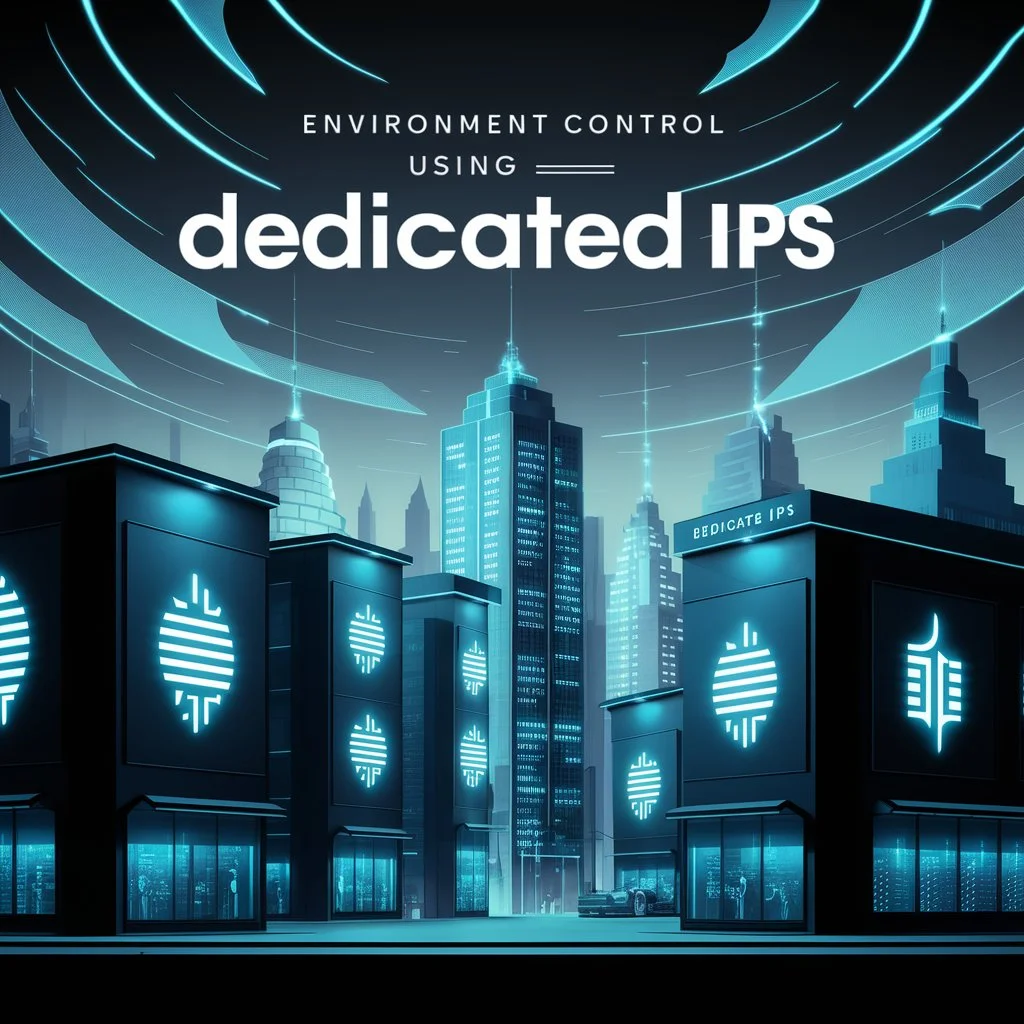In the vast landscape of network management, dedicated IP addresses stand as powerful tools for environment control.
These unique identifiers offer a level of precision and security that shared IPs simply can’t match. Understanding how to leverage dedicated IPs can significantly enhance your server configuration and overall network performance.
Localhost, often represented as 127.0.0.1, serves as a starting point for many developers and system administrators.
This special address allows for testing and development on a local machine before deploying to live servers. As we delve deeper into the world of IP networking, we’ll explore how localhost relates to broader concepts of dedicated IP usage.
- What is a dedicated IP address?
- How does it differ from shared IPs?
- Why is environment control crucial in modern computing?
These questions form the foundation of our exploration into dedicated IP addresses and their role in environment control. From basic definitions to advanced applications, we’ll cover the entire spectrum of this essential networking concept. Whether you’re a seasoned DevOps engineer or a curious newcomer to server management, this article will equip you with valuable insights and practical knowledge.
As we progress, we’ll examine various aspects of dedicated IP usage, including:
- Server isolation techniques
- Security implications and best practices
- Load balancing strategies
- Troubleshooting common issues
By the end of this journey, you’ll have a comprehensive understanding of how dedicated IP addresses can revolutionize your approach to environment control and network management.
Understanding Dedicated IP Addresses

A dedicated IP address is a unique Internet Protocol (IP) address assigned exclusively to a single device or server. Unlike shared IPs, which can host multiple websites or services, a dedicated IP belongs to you alone. This exclusivity offers several advantages in terms of control, security, and performance.
Let’s break down the key aspects of dedicated IP addresses:
- Definition: A unique numerical label for a single network interface
- Exclusivity: Not shared with any other user or service
- Control: Allows full management of the IP’s reputation and security
Dedicated IPs vs Shared IPs
The main difference between dedicated and shared IPs lies in their usage. Shared IPs host multiple websites or services on a single address. Dedicated IPs, on the other hand, serve only one entity. This distinction has important implications:
- Security: Dedicated IPs offer better isolation, reducing risks from other users’ actions.
- Performance: With no resource competition, dedicated IPs often provide faster response times.
- Reputation: Your IP’s reputation depends solely on your actions, not those of others.
Common Use Cases for Dedicated IPs
Dedicated IP addresses find application in various scenarios:
- E-commerce: Secure customer transactions and build trust
- Email marketing: Improve deliverability and avoid spam filter issues
- Gaming servers: Ensure stable connections and minimize latency
- VoIP services: Maintain call quality and reliability
- Custom SSL certificates: Enable HTTPS for enhanced security
For businesses, dedicated IPs can be crucial. They allow for easier whitelisting in corporate firewalls and provide a consistent point of access for clients and partners. Additionally, dedicated IPs simplify the process of setting up and managing virtual private networks (VPNs).
Technical Considerations
When working with dedicated IPs, keep these points in mind:
- IP versions: IPv4 is still common, but IPv6 is growing in importance.
- Subnet masks: These determine the network and host portions of an IP address.
- CIDR notation: A compact way to specify IP ranges, often used in network configurations.
Acquiring a dedicated IP usually involves an additional cost from your hosting provider or ISP. However, the benefits often outweigh this expense for businesses and individuals requiring precise control over their online presence.
In the next section, we’ll explore localhost and special IP addresses, including the significance of 127.0.0.1 in development environments. This knowledge will build on our understanding of dedicated IPs and their role in environment control.
Remember, dedicated IP addresses are powerful tools in network management. They offer unparalleled control and security, making them invaluable for many online operations. As we continue, we’ll delve deeper into how you can leverage these unique identifiers to enhance your digital infrastructure.
Localhost and Special IP Addresses

Localhost, often represented by the IP address 127.0.0.1, plays a crucial role in network programming and testing. This special address always refers to the current device, allowing developers to run and test servers without affecting external networks. Understanding localhost and other special IP addresses is key to mastering environment control.
The Significance of 127.0.0.1
The IP address 127.0.0.1 is more than just a number. Here’s why it’s important:
- It always points to the local machine
- It works without an active network connection
- It’s used for testing network services locally
When you access 127.0.0.1, you’re communicating with your own computer. This loopback mechanism is invaluable for developers who need to test web servers, databases, or other network services without deploying them to a live environment.
Other Special IP Addresses
While 127.0.0.1 is the most well-known special IP, there are others worth noting:
- 0.0.0.0: Represents all IP addresses on the local machine
- 255.255.255.255: The broadcast address for the current network
- 169.254.x.x: Link-local addresses used when DHCP fails
These special addresses serve specific purposes in networking and can be crucial in certain development or troubleshooting scenarios.
Localhost in Different Operating Systems
While 127.0.0.1 is universal, how it’s used can vary:
- Windows: Often uses ‘localhost‘ as a hostname
- Linux/Unix: May use 127.0.0.1 directly in configurations
- macOS: Supports both ‘localhost‘ and 127.0.0.1
Regardless of the OS, the concept remains the same: localhost provides a way to access network services on the same machine.
Practical Applications of Localhost
Developers and system administrators use localhost for various tasks:
- Web development: Testing websites before going live
- Database management: Configuring and testing database servers
- API development: Creating and testing APIs locally
- Network diagnostics: Checking if the network stack is functioning
Using localhost allows for rapid development cycles and safer testing environments. It’s an essential tool in the developer’s toolkit for environment control.
Localhost and Security
While localhost is generally secure, it’s not without risks:
- Some malware targets localhost services
- Misconfigured services on localhost can be exploited
- Localhost bypasses some network security measures
Always treat localhost services with the same security considerations as you would for public-facing services.
The Relationship Between Localhost and Dedicated IPs
Understanding localhost helps in grasping the concept of dedicated IPs:
- Localhost is like a dedicated IP for your local machine
- Both provide isolated environments for specific purposes
- Transitioning from localhost to a dedicated IP is often part of the deployment process
As you move from development to production, you’ll likely shift from using localhost to dedicated IP addresses for your services.
In the next section, we’ll explore port numbers and their significance in networking. This knowledge will build on our understanding of IP addresses and help explain how multiple services can coexist on a single machine or dedicated IP.
Remember, localhost is your local development playground. It’s where ideas are tested and refined before they face the wider internet. Mastering localhost is a step towards effective use of dedicated IPs in production environments.
Port Numbers and Their Significance

Port numbers work alongside IP addresses to direct network traffic. They act like apartment numbers in a large building, helping data find its way to the right application. Understanding ports is crucial for effective network management and environment control.
What Are Ports?
Ports are virtual points where network connections start and end. Key points about ports include:
- They range from 0 to 65535
- Lower numbers (0-1023) are reserved for well-known services
- Higher numbers are available for custom applications
Ports allow multiple services to run on a single IP address, whether it’s a dedicated IP or localhost.
How Ports Work with IP Addresses
The combination of an IP address and a port number is called a socket. For example:
- 127.0.0.1:8080 refers to port 8080 on localhost
- 203.0.113.1:80 might be a web server on a dedicated IP
This system allows for precise routing of network traffic, enabling complex applications and services to function smoothly.
Common Port Numbers and Their Uses
Some ports are standardized for specific services:
- Port 80: HTTP (web traffic)
- Port 443: HTTPS (secure web traffic)
- Port 22: SSH (secure shell)
- Port 25: SMTP (email transmission)
- Port 3306: MySQL database
Knowing these can help in configuring firewalls, troubleshooting connection issues, and understanding network logs.
Ports in Development Environments
When working on localhost, developers often use non-standard ports:
- 8080 or 8000 for web servers
- 3000 or 3001 for Node.js applications
- 5000 for Python’s Flask framework
This practice avoids conflicts with system services and allows multiple projects to run simultaneously.
Port Forwarding and NAT
In home and office networks, port forwarding plays a crucial role:
- It allows external access to internal services
- It’s essential for hosting games, websites, or remote access tools
- Network Address Translation (NAT) often requires specific port configurations
Understanding port forwarding is key when transitioning from localhost to a public-facing dedicated IP.
Security Considerations for Ports
Open ports can be security risks. Best practices include:
- Closing unnecessary ports
- Using firewalls to restrict access
- Employing port knocking or other security measures
- Regularly scanning for open ports
Proper port management is crucial for maintaining a secure network environment.
Troubleshooting Port-Related Issues
Common port problems and solutions include:
- Port already in use: Find and stop the conflicting process
- Connection refused: Check if the service is running and the port is open
- Timeout: Verify network connectivity and firewall settings
Tools like netstat, lsof, and nmap can help diagnose port-related issues.
Ports and Dedicated IP Environments
When using dedicated IPs, port management becomes even more important:
- Each service on the dedicated IP needs a unique port
- Proper port configuration ensures smooth operation of multiple services
- Load balancers often use port information to distribute traffic
Understanding the interplay between ports and dedicated IPs is crucial for effective environment control.
In the next section, we’ll explore how dedicated IPs facilitate environment control. We’ll build on our knowledge of IP addresses and ports to understand how they create isolated, manageable network spaces.
Remember, ports are the channels through which network communication flows. Mastering their use is essential for anyone working with dedicated IPs and complex network environments.
Environment Control Using Dedicated IPs

Dedicated IP addresses are powerful tools for environment control in computing. They allow for precise management of network resources, enabling developers and system administrators to create isolated, secure, and efficient digital spaces. Let’s explore how dedicated IPs facilitate environment control and why this matters.
What is an Environment in Computing?
In computing, an environment refers to the set of conditions under which a program or system operates. It includes:
- Hardware resources
- Software configurations
- Network settings
- Security parameters
Environments can be development, testing, staging, or production. Each serves a specific purpose in the software lifecycle.
How Dedicated IPs Enable Environment Control
Dedicated IPs provide several key advantages for environment control:
- Isolation: Each environment gets its own unique address
- Security: Easier to implement access controls and monitoring
- Consistency: Environments remain stable across different stages
- Scalability: Add or remove environments as needed
With dedicated IPs, you can create distinct environments that don’t interfere with each other.
Benefits of Using Dedicated IPs for Environment Management
Using dedicated IPs for environment control offers numerous benefits:
- Simplified troubleshooting: Issues in one environment don’t affect others
- Enhanced security: Restrict access to sensitive environments easily
- Improved performance: No resource competition between environments
- Better testing: Create realistic staging environments that mirror production
- Easier compliance: Meet regulatory requirements for data isolation
These advantages make dedicated IPs invaluable for businesses with complex IT needs.
Practical Examples of Environment Control
Here are some real-world applications of environment control using dedicated IPs:
- Development sandboxes: Isolated spaces for experimenting with new features
- QA environments: Dedicated testing areas that don’t impact live systems
- Staging servers: Near-exact copies of production for final checks
- Production clusters: Separate IPs for web, database, and application servers
Each environment can have its own security rules, performance settings, and access controls.
Challenges in Environment Control
While powerful, dedicated IP environments come with challenges:
- Cost: Each dedicated IP typically incurs additional charges
- Complexity: Managing multiple environments requires careful planning
- Synchronization: Keeping environments in sync can be challenging
- Resource allocation: Balancing resources across environments takes skill
Overcoming these challenges is key to effective environment control.
Best Practices for Environment Control
To make the most of dedicated IP environments:
- Use configuration management tools to maintain consistency
- Implement robust access controls for each environment
- Regularly audit and update environment configurations
- Automate environment provisioning and teardown
- Document the purpose and setup of each environment clearly
Following these practices ensures smooth operation across all environments.
The Future of Environment Control
As cloud computing evolves, environment control is changing:
- Containerization is providing new ways to isolate environments
- Software-defined networking is making environment management more flexible
- AI and machine learning are being used to optimize environment configurations
Dedicated IPs remain crucial in this evolving landscape, providing a stable foundation for these new technologies.
In the next section, we’ll dive into practical applications of dedicated IP environments. We’ll explore how businesses and developers use these tools in real-world scenarios to solve complex problems and improve their operations.
Remember, effective environment control with dedicated IPs is about creating order in the complex world of networked systems. It’s a skill that can significantly enhance the quality, security, and efficiency of your digital operations.
Practical Applications

Dedicated IP addresses and environment control find use in various real-world scenarios. From software development to production deployment, these tools help create efficient, secure, and manageable digital ecosystems. Let’s explore some key applications.
Development Environments
Developers use dedicated IPs to create isolated spaces for coding and testing:
- Local development: Use localhost (127.0.0.1) for initial work
- Shared development servers: Assign dedicated IPs to team environments
- Feature branch environments: Spin up isolated IPs for each new feature
Benefits of dedicated IPs in development:
- Prevent conflicts between developers’ work
- Easily share work-in-progress with team members
- Simulate production-like conditions early in development
Example: A web development team uses dedicated IPs for each developer’s environment. This allows them to work on different features without interfering with each other’s code.
Testing and Staging Servers
Quality Assurance (QA) teams rely on dedicated environments for thorough testing:
- Functional testing: Dedicated IPs for different test suites
- Performance testing: Isolated environments to measure system limits
- Security testing: Separate IPs for vulnerability scans and penetration tests
Advantages of dedicated IPs for testing:
- Replicate production-like conditions accurately
- Run multiple tests simultaneously without interference
- Easily reset environments between test runs
Example: An e-commerce company uses a dedicated IP for their staging server. This allows them to test new features and updates in an environment that closely mirrors production, without risking live customer data or transactions.
Production Deployment
In production, dedicated IPs play a crucial role in system architecture:
- Web servers: Separate IPs for frontend and backend services
- Database servers: Isolated IPs for data storage and retrieval
- Load balancers: Unique IPs for distributing traffic efficiently
Benefits of dedicated IPs in production:
- Improve security by isolating critical components
- Enhance performance through strategic resource allocation
- Simplify scaling by adding new servers with dedicated IPs
Example: A social media platform uses dedicated IPs for its web servers, database clusters, and content delivery network. This setup allows them to handle millions of users while maintaining performance and security.
Network Segmentation and Security

Dedicated IPs are valuable for creating secure network segments:
- DMZ (Demilitarized Zone): Separate IPs for public-facing services
- Internal networks: Unique IPs for different departments or functions
- VPNs (Virtual Private Networks): Dedicated IPs for secure remote access
Advantages in network security:
- Limit attack surfaces by isolating sensitive systems
- Implement precise firewall rules based on IP addresses
- Monitor and control traffic between network segments
Example: A financial institution uses dedicated IPs to create distinct network segments for customer-facing services, internal operations, and data storage. This segmentation helps protect sensitive financial data from potential breaches.
Compliance and Regulatory Requirements
Many industries have strict rules about data isolation and access control:
- Healthcare: Separate environments for patient data (HIPAA compliance)
- Finance: Isolated systems for financial transactions (PCI DSS requirements)
- Government: Dedicated environments for classified information
Benefits for compliance:
- Demonstrate clear data separation to auditors
- Implement access controls based on IP addresses
- Simplify log management and incident response
Example: A healthcare provider uses dedicated IPs to create isolated environments for patient records, billing systems, and research data. This setup helps them comply with HIPAA regulations and protect sensitive medical information.
In the next section, we’ll provide a step-by-step guide on setting up dedicated IP environments. This practical knowledge will help you implement these concepts in your own projects and systems.
Remember, the power of dedicated IPs lies in their versatility. From development to production, they provide the control and isolation needed for efficient, secure, and compliant operations.
Setting Up Dedicated IP Environments
Creating dedicated IP environments requires careful planning and execution. This guide will walk you through the process, from acquiring IPs to configuring your systems. We’ll also cover tools and best practices to ensure a smooth setup.
Step-by-Step Guide
- Acquire Dedicated IP Addresses • Contact your hosting provider or ISP • Determine how many IPs you need • Consider future growth in your planning
- Plan Your Network Architecture • Decide which services need dedicated IPs • Map out how traffic will flow between environments • Consider security and performance requirements
- Configure DNS Settings • Set up A records for each dedicated IP • Consider using subdomains for different environments • Ensure TTL (Time To Live) settings are appropriate
- Set Up Firewalls • Configure rules for each dedicated IP • Limit access to necessary ports and services • Implement rate limiting to prevent abuse
- Configure Servers • Assign dedicated IPs to appropriate network interfaces • Set up virtual hosts if using web servers • Ensure proper routing between servers
- Implement Monitoring • Set up alerts for each dedicated IP environment • Monitor bandwidth usage and server health • Track uptime and performance metrics
- Test Your Setup • Verify connectivity from external networks • Check that services are accessible as intended • Perform security scans to identify vulnerabilities
Tools for Managing Dedicated IPs
Several tools can help in setting up and managing dedicated IP environments:
- IPAM (IP Address Management) software
- Examples: SolarWinds IP Address Manager, Infoblox IPAM
- Helps track and manage IP allocations
- Network monitoring tools
- Examples: Nagios, Zabbix, Prometheus
- Monitor health and performance of dedicated IP services
- Configuration management tools
- Examples: Ansible, Puppet, Chef
- Automate server configuration across multiple environments
- Containerization platforms
- Examples: Docker, Kubernetes
- Simplify deployment and scaling of services on dedicated IPs
Best Practices and Considerations
When setting up dedicated IP environments, keep these points in mind:
- Documentation is crucial • Map out your network architecture • Keep records of IP assignments and their purposes • Document firewall rules and access policies
- Implement proper access controls • Use strong authentication for all services • Limit SSH access to specific IP ranges • Implement two-factor authentication where possible
- Regular maintenance is key • Keep all systems and software up to date • Regularly review and update firewall rules • Conduct periodic security audits
- Plan for scalability • Leave room for growth in your IP allocations • Use load balancers to distribute traffic as you scale • Consider cloud services for flexible scaling
- Backup and disaster recovery • Regularly backup configurations • Have a plan for quickly restoring services • Consider redundancy for critical systems
- Stay compliant • Ensure your setup meets industry regulations • Regularly review compliance requirements • Be prepared for audits
Setting up dedicated IP environments takes time and careful planning. But the benefits in terms of control, security, and performance make it worthwhile for many organizations.
In the next section, we’ll delve into advanced concepts related to dedicated IP usage. This will include topics like load balancing, geolocation, and the differences between IPv4 and IPv6.
Remember, a well-planned dedicated IP environment forms the backbone of a robust, secure, and efficient network infrastructure. Take the time to get it right, and you’ll reap the benefits in the long run.
Advanced Concepts

As we delve deeper into dedicated IP usage, several advanced topics come into play. These concepts can help you optimize your network infrastructure and leverage dedicated IPs to their full potential.
Load Balancing with Dedicated IPs
Load balancing distributes network traffic across multiple servers. With dedicated IPs, you can create robust load balancing setups:
- Round-robin DNS: Assign multiple IPs to a single domain
- Hardware load balancers: Use dedicated devices to route traffic
- Software load balancers: Implement solutions like HAProxy or NGINX
Benefits of load balancing:
- Improved performance and reduced latency
- Better fault tolerance and uptime
- Easier scaling of services
Example setup:
- Assign dedicated IPs to multiple web servers
- Configure a load balancer to distribute incoming requests
- Use health checks to route traffic only to available servers
Geolocation and Content Delivery Networks (CDNs)
Dedicated IPs play a crucial role in geolocation-based services and CDNs:
- IP-based geolocation: Determine user location for targeted content
- CDN edge servers: Use dedicated IPs for content caching near users
- Geoblocking: Restrict access to content based on IP location
Advantages:
- Faster content delivery to users worldwide
- Compliance with regional content restrictions
- Improved user experience through localization
Implementation tips:
- Acquire dedicated IPs in various geographic regions
- Use geolocation databases to map IPs to locations
- Implement CDN services for globally distributed content
IPv4 vs IPv6 Considerations
As IPv4 addresses become scarce, IPv6 is gaining importance:
- IPv4: 32-bit addresses (e.g., 192.168.1.1)
- IPv6: 128-bit addresses (e.g., 2001:0db8:85a3:0000:0000:8a2e:0370:7334)
Key differences:
- IPv6 offers a vastly larger address space
- IPv6 has built-in support for end-to-end encryption
- IPv6 simplifies network configuration with autoconfiguration
Transitioning to IPv6:
- Acquire IPv6 address blocks from your provider
- Update DNS records to include IPv6 addresses (AAAA records)
- Ensure your network equipment and software support IPv6
Anycast IP Addressing
Anycast allows multiple servers to share the same IP address:
- Routing directs requests to the nearest server
- Improves reliability and reduces latency
- Commonly used for DNS and CDN services
Setting up Anycast:
- Acquire a dedicated IP block for Anycast use
- Configure multiple servers with the same IP address
- Use BGP (Border Gateway Protocol) to advertise the IP from different locations
Virtual IP Addresses (VIPs)
VIPs are IP addresses not tied to a specific network interface:
- Used in high-availability setups
- Allow seamless failover between servers
- Common in load balancing and clustering scenarios
Implementing VIPs:
- Assign a VIP to a cluster of servers
- Use protocols like VRRP (Virtual Router Redundancy Protocol) for management
- Configure services to bind to the VIP rather than physical IPs
IP Reputation Management
With dedicated IPs, managing your IP reputation is crucial:
- Monitor blacklists and spam databases
- Implement proper email authentication (SPF, DKIM, DMARC)
- Maintain consistent, legitimate usage of your IPs
Best practices:
- Regularly check IP reputation using online tools
- Quickly address any issues that could harm your reputation
- Use separate IPs for different services (e.g., web, email, APIs)
In the next section, we’ll explore the security implications of using dedicated IP addresses. This will cover both the advantages they offer for security and potential risks to be aware of.
Remember, these advanced concepts can significantly enhance your network’s capabilities. However, they also require careful planning and ongoing management to implement effectively.
Security Implications

Dedicated IP addresses offer several security advantages, but they also come with their own set of risks. Understanding these implications is crucial for maintaining a secure network environment.
Advantages of Dedicated IPs for Security
Dedicated IPs provide several security benefits:
- Improved Access Control • Easily restrict access to specific IP addresses • Implement IP-based authentication for services • Create more precise firewall rules
- Better Monitoring and Logging • Track activity for each dedicated IP separately • Identify suspicious behavior more quickly • Simplify log analysis and incident response
- Enhanced SSL/TLS Implementation • Use unique SSL certificates for each IP • Avoid SSL certificate sharing issues • Implement stronger encryption policies per service
- Isolation of Services • Separate critical services onto different IPs • Limit the impact of a compromise on one service • Implement network segmentation more effectively
- Reputation Management • Maintain separate reputations for different services • Isolate potential spam or abuse issues • Protect your main IP from negative impacts of testing or development
Potential Risks and How to Mitigate Them
While dedicated IPs offer security benefits, they also present some risks:
- Increased Attack Surface Risk: More IPs mean more potential entry points for attackers. Mitigation: • Regularly scan all IPs for vulnerabilities • Keep all systems and services up to date • Use intrusion detection/prevention systems (IDS/IPS)
- Configuration Complexity Risk: More IPs can lead to misconfigurations and security gaps. Mitigation: • Use configuration management tools to maintain consistency • Regularly audit your IP configurations • Implement change management processes
- Targeted Attacks Risk: Dedicated IPs make it easier for attackers to target specific services. Mitigation: • Implement strong firewalls and access controls • Use DDoS protection services • Regularly change passwords and access credentials
- SSL/TLS Management Risk: Managing multiple SSL certificates can be challenging. Mitigation: • Use automated certificate management tools • Implement certificate pinning for critical services • Regularly audit and rotate SSL certificates
- Cost of Security Measures Risk: Securing multiple dedicated IPs can be expensive. Mitigation: • Prioritize security measures based on risk assessment • Consider managed security services for cost-effective protection • Regularly review and optimize your security spending
Best Practices for Securing Dedicated IP Environments
To maximize security with dedicated IPs:
- Implement a robust firewall strategy • Use both network and host-based firewalls • Regularly update firewall rules • Log and monitor firewall activity
- Use Virtual Private Networks (VPNs) • Encrypt traffic between different IP environments • Implement multi-factor authentication for VPN access • Regularly audit VPN logs
- Employ Intrusion Detection and Prevention • Set up IDS/IPS systems to monitor all dedicated IPs • Configure alerts for suspicious activity • Regularly update IDS/IPS rules and signatures
- Conduct Regular Security Audits • Perform vulnerability scans on all dedicated IP services • Conduct penetration testing to identify weaknesses • Review and update security policies regularly
- Implement Strong Access Controls • Use principle of least privilege for all services • Implement multi-factor authentication where possible • Regularly review and update access lists
In the next section, we’ll cover troubleshooting common issues related to dedicated IP addresses and environment control. This will help you maintain smooth operations and quickly resolve any problems that arise.
Remember, security is an ongoing process. Regularly reviewing and updating your security measures is crucial to protecting your dedicated IP environments effectively.
Troubleshooting Common Issues

Even with careful setup and management, issues can arise when working with dedicated IP addresses. Knowing how to diagnose and resolve these problems quickly is crucial for maintaining smooth operations.
Diagnosing IP Conflicts
IP conflicts occur when two devices on the same network try to use the same IP address.
Symptoms:
- Intermittent network connectivity
- Error messages about duplicate IP addresses
- Unexplained disconnections
Troubleshooting steps:
- Use the “ipconfig” (Windows) or “ifconfig” (Linux/Mac) command to check IP assignments
- Run a network scan to detect duplicate IPs
- Check DHCP server logs for unusual activity
Resolution:
- Manually reassign IP addresses to resolve conflicts
- Update DHCP server configurations to prevent future conflicts
- Use IP address management (IPAM) tools for larger networks
Resolving Connectivity Problems
Connectivity issues can stem from various sources when using dedicated IPs.
Common problems:
- Unable to reach a specific IP address
- Slow or intermittent connections
- Services not responding on expected ports
Diagnostic approach:
- Use “ping” to test basic connectivity
- Try “traceroute” to identify where connections fail
- Check “netstat” to verify listening ports
Solutions:
- Verify firewall rules allow necessary traffic
- Ensure routing tables are correctly configured
- Check for DNS resolution issues
Performance Optimization
Dedicated IP environments may experience performance issues over time.
Signs of performance problems:
- Increased latency in network operations
- Higher than normal CPU or memory usage
- Slow response times for services
Optimization steps:
- Monitor network traffic using tools like Wireshark
- Analyze server logs for bottlenecks
- Use performance benchmarking tools to identify issues
Improvements:
- Implement load balancing for high-traffic services
- Optimize database queries and indexes
- Upgrade hardware or network infrastructure if necessary
SSL Certificate Issues
Problems with SSL certificates are common in dedicated IP setups.
Typical issues:
- Certificate errors in web browsers
- Services failing to start due to certificate problems
- Expired or mismatched certificates
Troubleshooting process:
- Verify certificate expiration dates
- Check that certificates match domain names
- Ensure proper certificate installation on servers
Fixes:
- Renew expired certificates promptly
- Use wildcard certificates for multiple subdomains
- Implement automated certificate management
DNS Configuration Problems
DNS issues can prevent proper resolution of dedicated IPs.
Symptoms:
- Unable to reach services by domain name
- Inconsistent name resolution across different clients
- Long delays when accessing services
Diagnosis:
- Use “nslookup” or “dig” to check DNS records
- Verify DNS server configurations
- Check for DNS propagation issues
Resolutions:
- Update DNS records to reflect correct IP assignments
- Adjust TTL (Time To Live) settings for faster propagation
- Consider using a managed DNS service for complex setups
Tools for Troubleshooting
Several tools can aid in diagnosing and resolving dedicated IP issues:
- Ping: Test basic network connectivity
- Traceroute: Identify network path issues
- Nmap: Scan for open ports and services
- Wireshark: Analyze network traffic in detail
- Netstat: View network connections and routing tables
Best Practices for Issue Prevention
To minimize troubleshooting needs:
- Implement robust monitoring systems
- Regularly update and patch all systems
- Document your network architecture thoroughly
- Conduct regular security and performance audits
- Train staff on proper management of dedicated IP environments
In the next section, we’ll explore future trends in IP addressing and environment control. This will help you prepare for upcoming changes in network technology and management.
Remember, effective troubleshooting often requires a systematic approach. Start with the basics and work your way through more complex possibilities to identify and resolve issues efficiently.
Future Trends

The landscape of IP addressing and environment control is constantly evolving. Staying ahead of these trends is crucial for maintaining efficient and secure network operations. Let’s explore some key developments that are shaping the future of this field.
Evolution of IP Addressing in Cloud Environments
Cloud computing is changing how we use and manage IP addresses:
- Dynamic IP allocation: Cloud providers automatically assign and manage IPs
- IP address pooling: Flexible assignment of IPs across multiple cloud regions
- IPv6 adoption: Increased use of IPv6 in cloud environments for scalability
Impact on dedicated IP usage:
- More emphasis on logical separation rather than physical IP separation
- Increased need for IP address management (IPAM) tools in hybrid environments
- Greater flexibility in scaling and deploying services across multiple regions
Emerging Technologies and Their Impact
Several new technologies are influencing dedicated IP and environment control:
- Software-Defined Networking (SDN) • Programmable network infrastructure • Dynamic IP assignment and routing • Improved network segmentation and security
- Network Function Virtualization (NFV) • Virtualized network services (firewalls, load balancers, etc.) • Reduced reliance on dedicated hardware appliances • More flexible deployment of network functions across IPs
- Intent-Based Networking • Automated network configuration based on business intent • Self-optimizing networks that adapt to changing conditions • Simplified management of complex IP environments
- Edge Computing • Distributed processing closer to data sources • Need for efficient IP allocation at the network edge • Challenges in managing and securing widely distributed IP addresses
- 5G Networks • Massive increase in connected devices • New approaches to IP address management for IoT • Enhanced capabilities for network slicing and dedicated virtual networks
Artificial Intelligence and Machine Learning in Network Management
AI and ML are set to revolutionize how we manage IP environments:
- Automated troubleshooting: AI systems identifying and resolving IP conflicts
- Predictive maintenance: ML models forecasting network issues before they occur
- Intelligent traffic routing: AI-optimized path selection for improved performance
- Security enhancements: ML-powered threat detection and response
Challenges and Opportunities
As these technologies evolve, new challenges and opportunities emerge:
Challenges:
- Ensuring security in increasingly complex network environments
- Managing the transition from IPv4 to IPv6
- Maintaining compliance with evolving data protection regulations
Opportunities:
- More efficient use of IP resources through intelligent management
- Enhanced ability to scale and adapt network environments quickly
- Improved network performance and user experience
Preparing for the Future
To stay ahead of these trends:
- Invest in continuous learning and skill development
- Experiment with new technologies in controlled environments
- Develop strategies for gradual adoption of emerging technologies
- Stay informed about industry standards and best practices
- Collaborate with peers and participate in professional networks
In conclusion, the future of dedicated IP addressing and environment control is closely tied to broader trends in cloud computing, AI, and network virtualization. By understanding and preparing for these changes, you can ensure your network infrastructure remains efficient, secure, and future-proof.
As we wrap up this comprehensive guide, the final section will provide a concise conclusion, summarizing the key points we’ve covered and offering some final thoughts on the importance of mastering dedicated IP management and environment control.
Conclusion
Throughout this guide, we’ve explored the world of dedicated IP addresses and environment control. Let’s recap the key points:
- Dedicated IPs provide exclusive network identities for devices or services
- They offer enhanced control, security, and performance in various scenarios
- Proper management of dedicated IPs is crucial for effective environment control
We covered several important aspects:
- Understanding the basics of IP addressing and ports
- Practical applications in development, testing, and production environments
- Setting up and managing dedicated IP environments
- Security implications and best practices
- Troubleshooting common issues
- Future trends shaping the field
Key takeaways:
- Dedicated IPs are powerful tools for creating isolated, secure network environments
- Effective use requires careful planning, implementation, and ongoing management
- Security should always be a top priority when working with dedicated IPs
- Staying informed about emerging technologies is crucial for future-proofing your network
As technology evolves, the role of dedicated IPs in environment control will continue to change. By mastering these concepts, you’ll be well-equipped to handle current challenges and adapt to future developments in network management.
Remember, the world of dedicated IPs and environment control is vast and complex. Continuous learning and practical experience are key to success in this field. Keep exploring, experimenting, and expanding your knowledge to stay at the forefront of network management and security.

I’m Dariel Campbell, the guy who loves making your experience awesome at “Go Hawaii US.” Playing with stories and attractions is my thing. At Go Hawaii US, we’re here to make your visit stand out and shine. Let’s make your time in Hawaii unforgettable—come and join the fun at Go Hawaii US!












